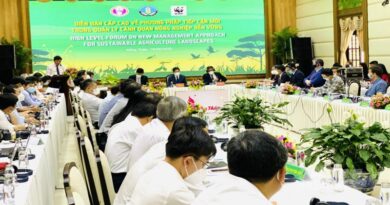New documentary charts restoration of Redonda Island from ‘lunar landscape’ to ecological tropical paradise
16 November 2022, Caribbean: A new documentary produced by the Environmental Awareness Group (EAG) in Antigua and Barbuda has charted its restoration of the country’s Redonda Island from that resembling to ‘lunar landscape’ to an ecological tropical paradise.
CABI, who served as the implementing agency for Global Environment Facility (GEF) that allowed the EAG to carry out its work on Redonda, was invited to attend the UK premiere of ‘Redonda: The Road to Recovery’ at The Biltmore Hotel in London.
In attendance at the screening was The Honourable Everly Paul Chet Greene, Antigua and Barbuda’s Minister of Foreign Affairs, Trade & Immigration as well as the country’s High Commissioner, Her Excellency Karen-Mae Hill.
The event was introduced by Dr Jeff Ardron, Adviser Ocean Governance, and included a question and answer session chaired by Emily Penn, Co-Founder and Director of eXXpedition. It featured Arica Hill, Executive Director, EAG, and Johnella Bradshaw, Redonda Ecosystem Reserve Co-ordinator.
Severely impacted by invasive species
Redonda is an uninhabited island that was discovered by Christopher Columbus in 1493 and is situated just over 56km southwest of Antigua. It became a dependency of Antigua in 1967 but prior to that, in the 1860s, it became a British possession.
The island had been rich in indigenous wildlife but this had become severely impacted by invasive species – particularly goats and rats which are believed to have entered the island from ships of the early explorers.
The goats were intentionally left on the land in case they were needed for food during a future expedition by the colonialists.
Redonda Restoration Programme
However, in order to help restore Redonda’s natural species – including the critically endangered Redonda Ground Dragon, the Redonda Ground Lizard, Redonda Dwarf Gecko and Redonda Tree Lizard, as well as numerous birds – the Redonda Restoration Programme was launched in 2016.
The partnership, involving the EAG, the Government of Antigua and Barbuda, Fauna and Flora International (FFI), the private sector and other international NGOs, began to remove around 60 goats and some 6,000 black rats.
The latter operation required the services of specialist rock climbers to lay bait in some of the more steep-sided cliffs on the island where the rats were nesting.
Within five years, the period charted in the documentary, Redonda has gone from a barren moonscape to a lush green environment with significant populations of nesting seabirds, resurging numbers of land birds and well as the aforementioned lizards.
Showcasing success
Ms Hill said, “The documentary allows us to show visually what you can’t always put into words. It gives us the chance to show to a wider audience the success of bringing an environment back from the brink of decline to one which is flourishing ecologically.
“The invasive species removal and recovery of Redonda demonstrates Antigua and Barbuda’s dedication to conservation efforts to ensure long-term species survival.”
The island is in the final stages of designation and will be designated as a Protected Area under the Environmental Protection and Management Act 2019 by the end of 2022, and will therefore be called the Redonda Ecosystem Reserve.
The film was produced by Antiguan filmmaker Lawson Lewis of Tarsier, through funding support from GEF, UNEP (United Nations Environment Programme), USFWS (US Fish and Wildlife Services), CABI; and through the support of partners which include the government of Antigua & Barbuda, Department of Environment, Fisheries Division, FFI, and Re:wild.
CABI’s work in the Caribbean
Back in 2021, a CABI-led initiative aimed at helping to reduce the risks of Invasive Alien Species (IAS) further blighting Barbados and Other Eastern Caribbean States (OECS) was approved for adoption across the Caribbean as part of a wider plan to encourage travellers to self-declare items that may pose a biosecurity risk.
The Caribbean Biosecurity Interceptions System (CBIS) – a database for interceptions at ports of entry – was approved at the 14th annual meeting of the Caribbean Plant Health Directors (CPHD).
It will help reduce the risks posed by IAS to native species such as the Barbados leaf toe geckoIt. It is hoped that with the strong endorsement by the CPHD that countries
Working as part of the GEF-funded project ‘Preventing Costs of Invasive Alien Species (IAS) in Barbados and Countries of the OECS,’ and together with the Biodiversity Conservation and Management Section of the Ministry of the Environment and National Beautification, CABI is helping to establish a conservation area for the creature at Paragon, Christ Church.
Other partners in the pilot study include the University of the West Indies and FFI.
Naitram Ramnanan, CABI’s Regional Representative, Caribbean, said, “CABI congratulates the efforts of the EAG and partners in bringing Redonda back from the brink of ecological decline to an environment which is free now free of invasive rats and goats that allowed its rich flora and fauna to flourish once again. However, there is still need to remove invasive plants and ensure no reinvasion occurs.”
The EAG is already encouraging citizens, residents and adventurers to refrain from visiting Redonda without their guidance and approval. These include sticking to guidelines summarized in a biosecurity checklist.
It includes a warning, for example, that seeds and insects – which can be damaging to the island’s ecosystem – can be transported on clothes and shoes.
Also Read: CropLife India appoints Durgesh C Sharma as the new Secretary General
(For Latest Agriculture News & Updates, follow Krishak Jagat on Google News)















